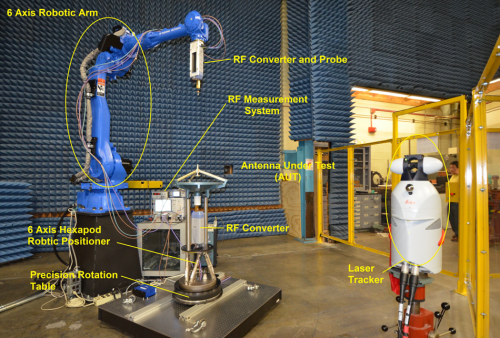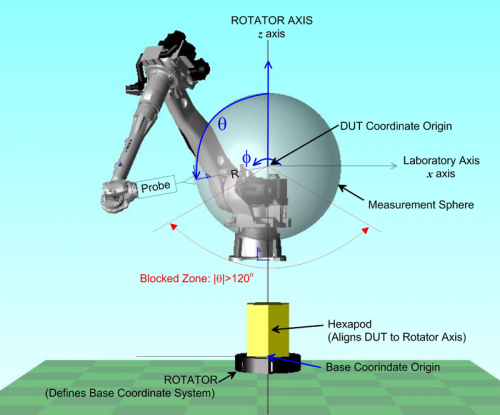High-tech measurements for high-frequency antennas

A team of researchers at PML's Antenna Metrology Lab in Boulder, CO has devised a first-of-its-kind system – combining a precision 3-meter industrial robot arm with a metrology-grade laser tracker and other apparatus – that can measure a probe antenna's position to within 50 micrometers while it is moving.
The facility, still under development, will bring a new and much-needed dimension of accuracy to the task of characterizing and calibrating antennas for use at 50 GHz to 500 GHz. That range spans the most important frequencies used by Earth-observation satellites for climate studies, and the higher frequencies are in growing demand for current and future telecommunications and imaging applications.
Currently, "there are no international reference standards for antennas at these frequencies," says team member David Novotny of the Radio-Frequency Fields Group in PML's Electromagnetics Division. "So there is no way to compare and validate measurements at different facilities. We hope to be able to measure probe antennas that are then used by others to characterize systems to a common baseline."
At present, the vast majority of such measurements are taken using planar systems in which the scanning stages for the probe antenna which sends/receives the signal are mounted on granite slabs for stability. These large mounting fixtures are scanned in front of the antenna under test (AUT). As a result, scan angles are usually constrained to about 35 degrees of arc (due to practical limits of planar scan geometries), which significantly limits the amount of information about the AUT that can be gathered.
More complete characterization requires a spherical scan that measures the AUT's performance from many different angles. That can be performed with multiple planar geometries; but re-aligning the AUT and probe to a fraction of a wavelength is an expensive, and slow process that is unsuitable for frequencies above 100 GHz.
Instead, the PML team created and is testing a multi-component, multi-sensor dynamic system with 12 degrees of freedom in movement and alignment: six from the industrial robot arm for the probe antenna, and six for aligning the AUT to the robotic stages.

Laser beams reflecting off targets on the apparatus track the probe position. Typically, the AUT transmitter is kept motionless while the probe antenna receiver sweeps through an arc of up to 240 degrees. Then the AUT is rotated by a small increment and another sweep is made. The process is repeated until the data build up a spherical picture of antenna performance.
A major advantage of the PML system is that it takes data while the probe antenna is continuously moving at a constant speed. "It's a dynamic measurement," says team member Joshua Gordon. "If you were to start and stop the arm for each measurement, it would shake the structure and it would take a lot of time for that vibration to dissipate. We avoid that problem, and we've been able to get high repeatability and to position the probe to within 50 micrometers, and track the probe within 25 micrometers."
That's the current figure. But "your allowable error is proportional to the wavelength," says team member Jason Coder. At 500 GHz (wavelength ~ 0.6 mm), it will be necessary to know the probe position to within 15 to 20 micrometers and to ensure that the probe is normal to the scan surface within 0.05 degrees. Moreover, a comprehensive characterization will require knowledge of the exact relative distance between the antennas as well as the relative alignment of their apertures. Those are the goals of the team's ongoing research at the new facility.
At present, there are two principal applications for the technique. One is in the nation's evolving telecommunications systems, which will soon have to expand into higher frequencies as available spectrum at conventional frequencies become saturated.
A more immediate use is in calibrating the antennas used in satellite Earth-observation measurements. "Most remote observations from space are done with microwaves," says James Whetstone, who heads NIST's Greenhouse Gas and Climate Science Measurement program. "So improving the fundamental microwave metrology will ultimately hasten advances in remote sensing. Higher-frequency microwave observing systems will evolve, and this work will further that progress."
Detailed characterization of antennas may also improve resolution of key variables such as the 183 GHz water vapor signal. "Better spatial resolution at the surface and in the near atmosphere can provide essential information on the disposition and movement of water – notably drinkable water – on the surface," Whetstone says.
Understanding satellite antennas in detail can also minimize another potential source of error: side lobes in the antenna's radiation pattern. "For satellite observation work, the spherical measurements tell you a lot of important information that you simply can't get with planar scanning, such as the behavior of side lobes. Say your spacecraft itself is radiating at certain frequencies similar to the signal. If there is a side lobe to the pattern, energy can enter that way and distort your measurements."
The robot-arm/laser tracker system is particularly well suited to instrument clusters for orbiting satellites. "Often the chief item of interest isn't the antenna and its circuitry per se, but how multiple systems perform in concert," Coder says, "and we can accommodate a much larger test payload than a single antenna. With the new facility, if a customer was interested, we could put the entire small satellite—up to 2 meters in diameter—in here and characterize the system as a whole, which would be a huge advantage."
There may be other possible applications as well. The Journal of the CMSC (Coordinate Metrology Systems Conference), which is devoted to all kinds of 3-D measurement, featured the PML team's work in its Autumn, 2013 issue. Each year only the top eight papers from the CMSC conferences are granted publication in the Journal of the CMSC. "We were encouraged by that," Gordon says, "because it suggests that our system may be of interest to people in very different fields."
Provided by National Institute of Standards and Technology



















